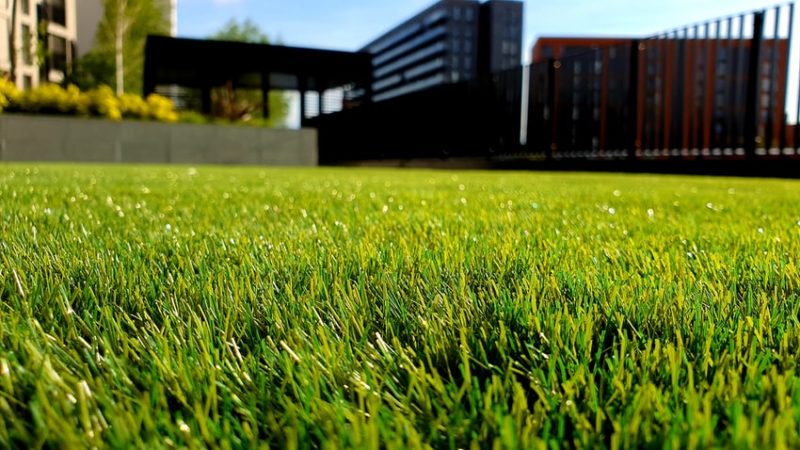How to Overseed a Lawn
An effective lawn care strategy consists of proper watering, mowing, fertilization, edging, and weed control. Unfortunately, some homeowners assume caring for their lawn is as simple as turning on their sprinklers before retiring to bed.
Unbeknownst to most aspiring lawn care enthusiasts, keeping a lawn in tip-top condition is more than just understanding the recommended watering and fertilization techniques. In most circumstances, a thoughtfully-designed lawn care strategy will entail overseeding-related duties.
What exactly is overseeding? In layman’s terms, overseeding is the process of increasing grass density, which makes your lawn appear lusher. Most homeowners use overseeding to restore conspicuously-sparse grass sections. If executed correctly, this step can make your lawn look a lot more visually-appealing to passing neighbors or houseguests attending your backyard barbeque. More practically, overseeding can equip your yard with the tools necessary to battle against diseases and prevent insect infestations.

If you’re interested in keeping your lawn in pristine condition, look for reputable seed suppliers such as Nature’s Seed. Besides consulting with experienced lawn experts, you should also try to master the art of overseeding using the tips below.
Prepare the patches
As a first step, prepare the sparse grass section for seeding. To do so, mow the lawn extremely short for a neat and tidy appearance. Then, dispose of any remaining clippings. Your goal should be to enable new seeds to rest on the soil’s surface. By removing grass blades that can obstruct sunlight and trickling water, these seeds will feel adequately quenched and able to enjoy full sunlight exposure.

After mowing your yard, use a metal thatch rake to clear debris such as clippings and thatch. Getting rid of this waste with a rake can help tidy the area and loosen the compacted dirt simultaneously, opening up the soil in preparation for seeding.
Calculate your lawn size
For quick answers, you can determine your lawn size using a measuring wheel. You can also calculate the square footage of your lawn by multiplying its length and width. If you’re dealing with multiple grassy sections, you’ll need to measure, record, and add these square footage totals together.

Fertilizing
Put fertilizing on hold for a little while. If you want to get your lawn all set for the upcoming overseeding work, refrain from applying fertilizer for a minimum of 30 days. Fertilizer stimulates grass growth, causing the seed to sprout more rapidly. If you apply fertilizer prematurely, fresh seeds may not be able to gain traction right off the bat.

Address existing lawn issues
Resolving your pre-existing lawn issues before overseeding sparse grass patches will ultimately serve you in the long-run. If you have lawn problems that have absolutely nothing to do with unusually sparse grass sections, now’s the time to resolve them. Putting off this laundry list of lawn maintenance could negatively impact grass growth, resulting in a patchy lawn.

For optimal results, lawn care experts recommend assessing the quality of your soil and balancing its pH levels before starting the overseeding process. To create a safe environment for seedlings to grow, you might want to remove deteriorating plant material. You should always do everything in your power to promote seed growth and direct moisture from the air into your soil.
Identify your current grass type
You should put thought and time into pinpointing the kind of grass you have. You should also conduct necessary research to identify the types of grass you’re interested in growing. If you take this extra step, you care for your existing grass appropriately and cater to its unique set of needs.

For starters, you’ll need to account for your region’s climate when planning your maintenance calendar. To ensure the success of your overseeding efforts, zoom in closely on already-existing grass blades, and record your observations. This way, you can get a better sense of your grass texture.
Organize your watering schedule
Well-established watering practices are a priceless tool for any homeowner hoping to master lawn overseeding. If you’ve just overseeded your yard, then you’ll need to take care of it in the right way. Overseeded lawns crave constant moisture, which is why you’ll need to hydrate your grass seeds and the surrounding soil regularly.

How exactly can you do this? You can ensure high moisture levels by implementing regular yet moderate watering sessions. Schedule these watering sessions twice a day, preferably once in the morning and once at night. Keep this up for the initial four full days.
As a lawn owner, you’ll need to do your best to promote the establishment of deep roots. Prepping your lawn for optimal root growth and health should be a top priority, as well.
Conclusion
Some homeowners aren’t sure when they should start overseeding their lawns.The truth is that it depends on where the individual resides. People who live in the northern part of the United States often decide to overseed their lawns during the autumn season. Fall overseeding lends to optimal growth since this time of year renders cool air and warm soil. As an added benefit, weeds are also few and far between during the fall season.









